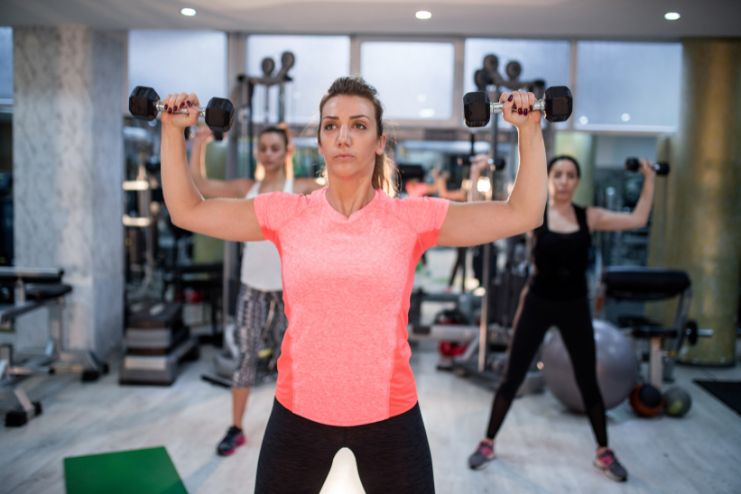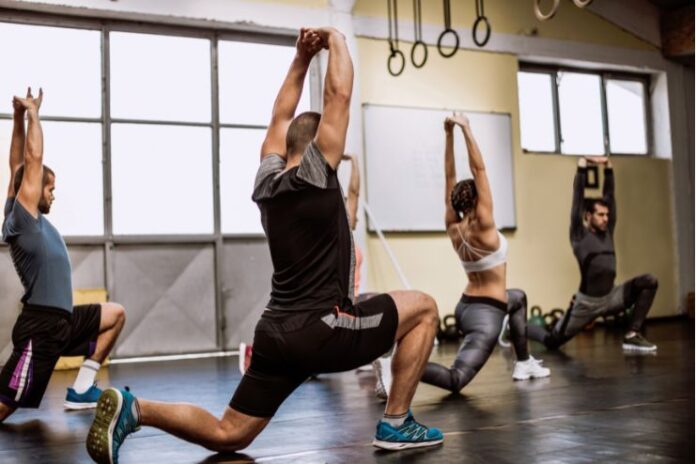Affiliate Disclaimer
Some links in this article are affiliate links. We may earn a small commission if you make a purchase through these links, at no extra cost to you. We only recommend products we find useful to our readersIsometric exercises involve holding a muscle contraction without movement, like holding a plank position. Dynamic exercises, on the other hand, involve movement through a range of motion, such as performing push-ups.
The debate between these two methods is significant for strength training, as each offers unique benefits. Isometric exercises can enhance strength at specific joint angles and are beneficial when movement is limited due to injury.
However, they may not improve strength across the entire range of motion. Dynamic exercises engage muscles through various movements, promoting overall strength and functional fitness. They also incorporate concentric and eccentric muscle actions, which are essential for muscle development.
Incorporating isometric and dynamic exercises into a fitness routine can provide comprehensive strength benefits, enhancing overall fitness and performance.
READ MORE: Why Couples Who Exercise Together Stay Together
Understanding Isometric Exercises

Isometric exercises entail contracting muscles without altering joint motion or muscle length. This means you engage your muscles without actually moving them. For example, when you hold a plank position, your muscles work hard to keep you stable, but no movement is involved.
How They Work
In isometric strength training, you maintain a specific position, creating tension in targeted muscles. Common examples include:
- Planks: Holding your body straight and rigid while resting on your forearms and toes.
- Wall Sits: Sitting against a wall like an invisible chair beneath you.
- Squat Holds: Lowering into a squat position and holding it without moving.
These strength training exercises focus on keeping muscles engaged without changing their length.
A common question is whether isometric exercises require equipment. The answer is no. Isometric strength training typically doesn’t require any equipment. It utilizes your body’s resistance, making it convenient to perform anywhere.
Benefits
- Builds Static Strength and Endurance: Isometric exercises enhance muscle strength by keeping muscles under constant tension.
- Improves Joint Stability and Injury Prevention: Strengthening the muscles around joints promotes stability and reduces the risk of injuries.
- Strengthens Muscles Without Stressing Joints: Since there’s no movement, isometric strength training is gentle on the joints, making it ideal for rehabilitation and individuals with joint issues.
Best Isometric Exercises
- Planks – Engages the core, shoulders, and back muscles.
- Wall Sits – These exercises work the glutes, hamstrings, and quadriceps.
- Isometric Push-Ups – Holding the lowered position of a push-up to work the chest, shoulders, and triceps.
- Static Squat Holds – Focuses on the lower body muscles, enhancing strength and endurance.
Another question you may ask is can isometric exercises improve athletic performance? The answer is yes. Incorporating isometric strength training into your routine can enhance muscle strength, stability, and endurance, which are crucial for athletic performance. They help in building a solid foundation and improving overall functional fitness.
Expert’s Views
According to Dr. Edward R. Laskowski, isometric exercises involve muscle contractions without noticeable changes in muscle length or joint movement.
These exercises help maintain strength and can also build strength, though not as effectively as other methods. Additionally, they can be performed anywhere, making them a convenient option for strength training.
READ NEXT: Functional Exercises for Everyday Activities
Understanding Dynamic Exercises

Dynamic exercises involve movements where muscles actively lengthen and shorten, engaging in concentric (shortening) and eccentric (lengthening) contractions. These movements are key components of strength-building workouts and help improve coordination and flexibility.
How They Work
During dynamic exercises, muscles work through a full range of motion using two primary types of contractions:
- Concentric Contractions – Muscles shorten while generating force (e.g., lifting a weight during a bicep curl).
- Eccentric Contractions – Muscles lengthen under tension (e.g., lowering a weight back to its starting position).
This combination strengthens muscles, improves flexibility, and supports endurance training.
Benefits
- Builds Functional Strength for Everyday Movements – Dynamic exercises mimic real-life activities, making daily tasks easier.
- Enhances Muscle Power, Endurance, and Flexibility – These exercises improve strength-building workouts by engaging multiple muscle groups.
- Improves Cardiovascular Health – Many dynamic movements elevate heart rate, making them effective for endurance training.
Now, the question arises: Are dynamic exercises better for weight loss? Well, the answer is in the affirmative. Dynamic exercises are highly effective for weight loss.
Since they engage in multiple muscle groups, they burn more calories than static exercises. Combined with a balanced diet and regular strength-building workouts, they can help with fat loss and body toning.
Best Dynamic Exercises
- Squats – Strengthens the lower body, including quadriceps, hamstrings, and glutes.
- Push-Ups – They strengthen the core, triceps, shoulders, and chest.
- Deadlifts – Engages the back, glutes, hamstrings, and core, making them great for strength-building workouts.
- Lunges – Improves balance while targeting leg and glute muscles.
- Bench Presses – Focuses on upper-body strength, working the chest, shoulders, and triceps.
Incorporating these dynamic exercises into your routine can boost endurance training, improve cardiovascular health, and enhance overall fitness.
Expert’s Views
Dr. Zac Turner, a prominent Australian physician, emphasizes the multifaceted benefits of dynamic exercises like kickboxing. He notes that such activities enhance physical fitness and boost brain health by promoting neuroplasticity and improving coordination.
Dr. Turner states kickboxing combines high-intensity aerobic and anaerobic exercises, promoting neuroplasticity, brain coordination, and prefrontal cortex activity.
READ MORE: Dynamic Vs. Static Stretching
Key Differences Between Isometric and Dynamic Exercises

Understanding the distinctions between isometric vs. dynamic exercises is essential for designing an effective functional fitness routine. Both types offer unique benefits, making them valuable in different training scenarios.
Muscle Engagement: Static vs. Full Range of Motion
- Isometric Exercises: Exercises include static contractions of the muscles without joint movement. Muscles hold a position under tension, improving endurance without motion.
- Dynamic Exercises: Require muscles to contract and lengthen through a full range of motion, promoting flexibility and mobility.
Strength Gains: Endurance vs. Power
- Isometric Exercises: Primarily build muscular endurance and stability, making them helpful in improving posture and preventing muscle imbalances.
- Dynamic Exercises: Focus on muscle power and explosive strength, supporting activities that require movement, such as running, jumping, and lifting.
Injury Prevention: Low-Impact vs. Higher Risk
- Isometric Exercises: Since they are low-impact, they place minimal stress on joints, making them ideal for rehabilitation and individuals recovering from injuries.
- Dynamic Exercises: While effective for functional fitness, they involve movement that, if performed incorrectly, may lead to a higher risk of injury.
Practical Application: Rehabilitation and Endurance vs. Athletic Performance
- Isometric Exercises: Best for rehabilitation programs and enhancing muscular endurance without joint strain.
- Dynamic Exercises: Essential for improving functional fitness, cardiovascular health, and sports performance by mimicking real-life movements.
A well-balanced training program should include isometric vs. dynamic exercises to maximize strength, endurance, and overall fitness.
READ NEXT: Benefits of Balloon Exercises
Which One is Better for Strength?

Choosing between static vs. dynamic workouts depends on your fitness level, goals, and training needs. Both types of exercises play a crucial role in strength-building workouts and can be combined for the best results.
By incorporating both static vs. dynamic workouts, individuals can create a well-rounded strength training program that maximizes endurance, stability, and power while minimizing the risk of injury.
For Beginners
Dynamic exercises are the best starting point for beginners because they improve overall strength and develop proper movement patterns essential for daily activities. Exercises like squats, lunges, and push-ups enhance functional fitness, making walking, lifting, and bending easier while reducing the risk of injury.
For Athletes
A mix of static and dynamic workouts provides the ideal balance for athletes looking to enhance performance. While dynamic exercises such as sprinting, jumping, and weightlifting improve explosive power, isometric exercises strengthen muscles, improve endurance, and stabilize joints, helping prevent injuries during intense training or competitions.
For Injury Recovery
Isometric exercises are a safe and effective option for rehabilitation because they allow muscle engagement without straining the joints. Holding a position under tension, these exercises help maintain strength, prevent muscle atrophy, and support recovery without aggravating existing injuries.
For Maximum Strength Gains
To build maximum strength, dynamic workouts combined with weightlifting techniques and progressive overload are the most effective. Exercises like deadlifts, squats, and bench presses gradually increase resistance, leading to muscle growth, improved power, and enhanced overall physical performance.
READ MORE: Find the Perfect Balance with Strength Training & Cardio
Combining Isometric and Dynamic Exercises for Optimal Strength

Integrating muscle contraction exercises like isometric and dynamic movements into your fitness regimen can lead to comprehensive strength development, improved stability, and enhanced performance.
Here’s how to effectively combine both types of exercises:
How to Use Both in a Workout Program
To maximize the benefits of both static and dynamic workouts, consider these strategies:
- Warm-Up: Start with dynamic movements such as jumping jacks or arm swings to increase blood flow and activate muscles.
- Integration: Combine isometric holds within dynamic exercises. For example, hold a squat at the lowest position for a few seconds before standing up.
- Balance: Alternate between isometric and dynamic movements to engage different muscle fibers, build endurance, and enhance functional fitness.
Example Training Plan Integrating Isometric and Dynamic Exercises
A well-rounded strength-building workout could include:
- Warm-Up: 5-10 minutes of dynamic stretches (e.g., leg swings, high knees).
- Circuit Training:
- Dynamic Exercise: Squats – 3 sets of 12 reps.
- Isometric Exercise: Wall sits – 3 sets of 30-second holds.
- Dynamic Exercise: Push-ups – 3 sets of 10 reps.
- Isometric Exercise: Planks – 3 sets of 45-second holds.
- Cool-Down: Stretching to improve flexibility and muscle recovery.
How Contrast Training Benefits from Both Methods
Contrast training, which pairs isometric and dynamic exercises, enhances neuromuscular efficiency and athletic performance.
For example, performing heavy squats (dynamic) followed by squat holds (isometric) improves power, speed, and endurance. This approach optimizes muscle contraction exercises, leading to greater strength gains over time.
READ NEXT: 6 Effective Workouts You Can Do at Home
Common Mistakes to Avoid

Both isometric and dynamic exercises offer great benefits, but common mistakes can lead to injury or hinder progress. The following are some common risks to watch out for:
Isometric Exercise Risks:
- Holding a position for too long without proper breathing can increase blood pressure and cause dizziness, making it particularly risky for individuals with hypertension. It’s important to focus on steady breathing and avoid excessive strain.
- Tensing muscles too hard may lead to muscle strain and discomfort.
- Lack of movement can reduce blood circulation, potentially causing numbness or tingling.
Dynamic Exercise Risks:
- Using momentum instead of controlled movements reduces effectiveness and raises the risk of joint injuries.
- Not warming up properly before workouts can lead to muscle stiffness and increase the chance of injury.
- Skipping cooldowns can cause post-workout soreness and hinder muscle recovery.
To stay safe, it’s crucial to maintain correct posture and gradually increase intensity. Including resistance training in a balanced workout routine can help build strength safely and effectively.
For individuals with high blood pressure, consulting a doctor before adding isometric workouts is always recommended to ensure a safe fitness routine.
READ MORE: Exploring Fun Cardio Dance Workouts
Conclusion

Dynamic and isometric exercises are essential for strength training and general fitness. While dynamic workouts improve muscle power, flexibility, and functional movement, isometric exercises help develop endurance and stability.
It is best to incorporate both forms within your training regimen for balanced strength growth. Dynamic movements increase cardiovascular health and mobility, whereas isometric holds improve muscular activation.
The most effective strategy is to customize exercises according to personal fitness objectives, whether for general strength, athletic performance, or recovery. For a comprehensive and successful fitness journey, start combining both forms of exercise into your regimen today.
References
- https://www.mayoclinic.org/healthy-lifestyle/fitness/expert-answers/isometric-exercises/faq-20058186
- https://pmc.ncbi.nlm.nih.gov/articles/PMC9934453/
- https://painfreephysiotherapy.com/isometric-exercises-examples-and-benefits/
- https://www.issaonline.com/blog/post/master-the-wall-sit-good-form-variations-common-mistakes
- https://fitpass.co.in/blog/why-you-should-include-isometric-exercises-in-your-workout-routine
- https://www.transparentlabs.com/blogs/all/isometric-exercises
- https://evofitness.ch/squat-hold/
- https://www.sciencedirect.com/topics/medicine-and-dentistry/dynamic-exercise
- https://www.goodrx.com/well-being/movement-exercise/static-stretching-vs-dynamic-stretching
- https://www.medicalnewstoday.com/articles/dynamic-stretching
- https://www.hss.edu/article_static_dynamic_stretching.asp
- https://vertimax.com/blog/top-20-isometric-exercises-for-static-strength-training
- https://shedefined.com.au/wellbeing/fitness/isometric-vs-dynamic-exercises-whats-the-difference/
- https://milehighspine.com/dynamic-and-isometric-exercises-101/
- https://pmc.ncbi.nlm.nih.gov/articles/PMC9934453/
- https://texasspineandsportstherapy.com/dynamic-vs-static-exercises-build-strength/
- https://milehighspine.com/dynamic-and-isometric-exercises-101/
- https://www.ifit.com/blog/to-plank-or-not-to-plank/
- https://www.mdpi.com/2076-3417/13/16/9069
- https://milehighspine.com/dynamic-and-isometric-exercises-101/
- https://thepacemakers.in/blog/the-art-of-holding-and-moving:-isometric-vs.-isotonic-exercise-for-overall-fitness
- https://www.hollyroser.com/the-power-of-isometric-training-in-muscle-building-a-guide-to-isometric-exercises-for-muscle-growth/
- https://www.medicalnewstoday.com/articles/isometric-exercises#risks
- https://uk.style.yahoo.com/six-habits-may-sabotaging-fitness-150000551.html
- https://risetrainingmn.com/blog/7-common-mistakes-to-avoid-when-strength-training
- https://texasspineandsportstherapy.com/dynamic-vs-static-exercises-build-strength/
In this Article




















